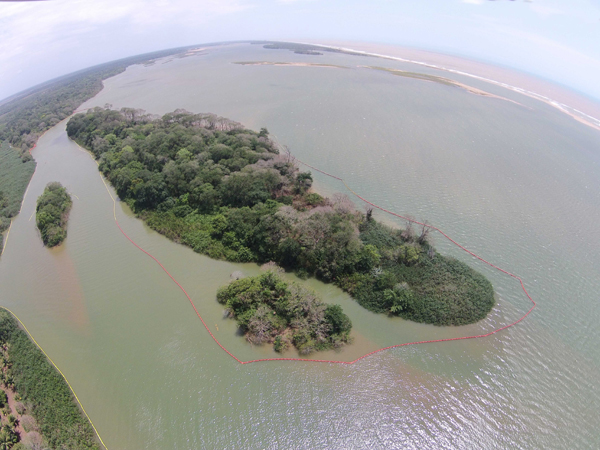Samarco continues implementing the measures determined by the Public Prosecution Service, Iema (State Environmental Agency), Projeto Tamar and the Instituto Chico Mendes to direct the turbidity plume to the sea and protect the fauna and flora in the Doce River estuary.
The recommendation of these institutions and environmental organizations is to allow the turbidity plume to reach the sea, which is the most appropriate body of water to receive it. According to the specialists, the material will thus be diluted more quickly due to the volume of water involved, as opposed to what would happen if it remained stationary in the estuary.
To this end, Samarco is supplying equipment to remove the sand banks which impede the river´s access to the ocean on the south side of the river mouth. Four machines are working 24/7 on the excavation, with the help of a dredge and equipment to pump the plume. The nine thousand meters of barriers continue to be installed along the length of both river banks and some islands located in the estuary. It is important to point out that the objective of these barriers is to protect the fauna and flora inhabiting these areas, rather than to keep the plume from reaching the sea.
Actions carried out by Samarco as determined by the government authorities and environmental organizations:
- Removal of the sand banks located close to the mouth of the river so that the turbidity plume can flow freely towards the sea.
- Installation of nine thousand meters of offshore and sea fence barriers along the banks of the river to protect the local fauna and flora as the turbidity plume travels downstream
- The installation of the barriers started on the southern part of the mouth, at Regencia, leading to Povoação in the region of Linhares.
- A mapping was performed of the areas and ecosystems of the estuary region, helping to define the optimal type of barrier to be used at each point. The planning also took into account the speed of the current and the depth of the river at these points.
- Four work fronts, involving over 50 people and several boats, are working simultaneously on this installation.
- The barriers installed range from 60 cm to 2.1 m in height. The height is adjusted according to the depth of each installation point, to optimize the contention of the plume.
- The barriers are made of waterproof canvas and are attached to the bottom of the river. They are highly resistant and can withstand winds of 20km/hour and waves 3 m high. They are widely used in accidents with oil spills and are very effective.
- Starting November 21st, aerial monitoring of the area will be performed using equipment called OceanEye. This consists of a balloon equipped with a camera, containing a triple sensor which can produce high resolution imagery in real time, day and night, with geo-location coordinates, thus generating an accurate mapping of the region.
- To assist with the planning of the actions, Samarco has hired an international company specialized in environmental emergencies, with experience in events such as the Katrina hurricane and subsequent flooding in New Orleans. The implementation of the actions is being handled by an international company specialized in environmental protection of the rivers and sea waters of Brazil.
